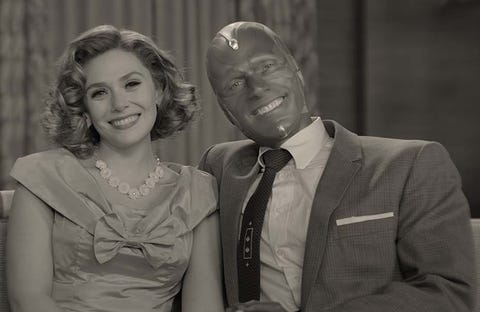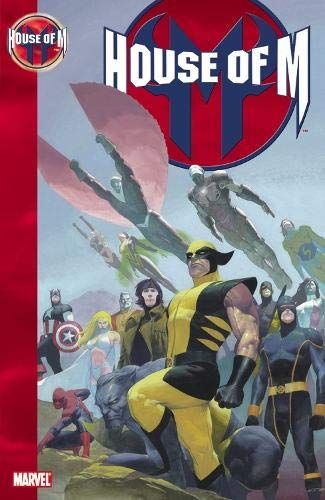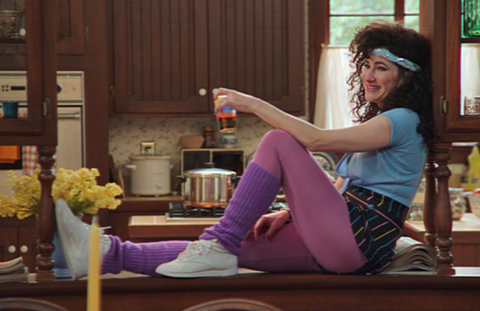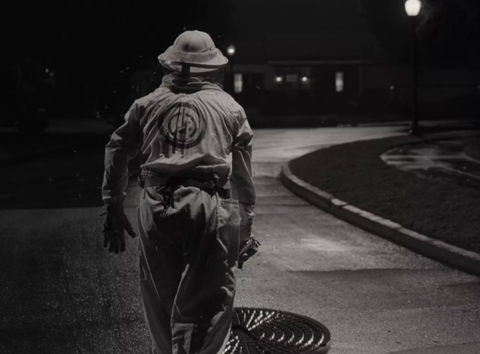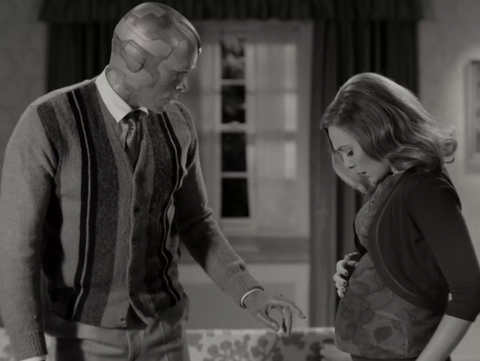By the end of 2020, the Marvel Cinematic Universe had started to feel a bit…stale. Part of what makes the superhero genre so universally captivating is its ability to go places that seem too far for other mediums. But by the end of Avengers: Endgame, the MCU was closing the door on a chapter that, no matter how wildly successful, had followed a series of predictable patterns. While that doesn’t make watching Tony Stark save the world any less satisfying, it does make it less nerdy. And no matter how mainstream superheroes get, there’s always a part of the genre that deserves its place in the realm of the nerd, where fan-fueled calculus thrives.
Now, with the explosion of new MCU series rolling out on Disney+ (at least four by the end of 2021), the superhero empire is reigniting fan theory fervor. When WandaVision dropped on January 15, the sitcom-turned-horror-show experiment heralded a bold new path for comic-book narratives. Turns out, superheroes can make for pretty hilarious sitcoms! But, most importantly, WandaVision—at least initially—seems intent on not spoon-feeding fans a story they’ve seen before. Which means, of course, that the fan theory machine is running hot.
WandaVision takes place after Endgame, and it stars Elizabeth Olsen and Paul Bettany as a delightfully well-matched Wanda Maximoff and Vision, basking in newlywed (?) bliss in the quaint 1950s-era suburb of Westview. They don’t exactly know how they got here, or what they’re doing in the 1950s. But they roll with it: befriending neighbors, hosting talent shows, nearly spoiling dinner with Vision’s boss, and trying not to wither under the critical eye of local Karen, Dotty (Emma Caulfied Ford). But increasingly, Wanda has a feeling something isn’t right. She keeps hearing voices on the radio, and at the end of episode 2, she and Vision watch an ominous beekeeper rise from beneath a manhole cover.
New episodes drop every Friday, and as the puzzle pieces come together, we’re gathering the best fan theories from around the internet. Here, we’ll try to make sense of what’s happening to Wanda—and why it matters for the next phase of Marvel stories.
Theory #1: WandaVision is a spin on the comics arc House of M.
If you’ve spent any time digging around Marvel fan forums, you’ve probably already stumbled on this theory. In 2005, Marvel Comics released a storyline called House of M, written by comics legend Brian Michael Bendis, in which an insane Scarlet Witch (aka Wanda Maximoff) has a mental breakdown and attempts to recreate the universe. You see, she’s lost her two children—Billy and Tommy—as well as her grip on reality. The other Avengers and X-Men (in the comics, Wanda is a mutant) realize they must consider killing Wanda, because her reality-shaping powers pose an enormous threat to humanity if she cannot recover her sanity. Yikes.
Hearing the news of her pending execution, Wanda creates a new world, an almost-perfect utopia where her children are alive, her superhero teammates are happy, and mutants rule the world. But it’s a dangerous lie, and when Wanda realizes what she’s done, she decides the solution is to rid the world of mutants like her. (You might have seen a comic panel circulating of Wanda whispering, “No more mutants.”) At that point, the majority of the mutant population lose their powers.
It’s unlikely WandaVision will mirror House of M exactly, because at this point in the MCU, the X-Men and Avengers’ worlds have not yet collided. But it’s certainly possible that Wanda has created an alternate universe out of grief. If you remember the events of Avengers: Infinity War and Endgame, you’ll recall that Wanda is forced to kill Vision while extracting an Infinity Stone from his forehead. He does not return to life in Endgame, and she tells Thanos, “You took everything from me.”
It’s not far-fetched to think Wanda created a new universe after Endgame, one in which she lives a picture-perfect sitcom life with Vision. But perhaps, like in House of M, the real world is not as simple as it seems, and someone is trying to bring her back to her senses.
Theory #2: WandaVision will tie directly into Doctor Strange in The Multiverse of Madness.
This theory is less about if than how. Marvel Studios president Kevin Feige confirmed WandaVision will tie into the film, and Olsen will star alongside Benedict Cumberbatch in March 2022’s The Multiverse of Madness. So, what does that mean? Well, the theory of Wanda creating her own alternate reality within the multiverse is almost definitely true. And if she shows up in the next Doctor Strange, someone must pull her out of the sitcom-verse—and it could be the Master of the Mystical Arts himself.
Theory #3: Agnes is actually Agatha Harkness.
Here’s one that requires you to know a bit more comic lore. You met Agnes (Kathryn Hahn), Wanda and Vision’s deliciously wry neighbor, in the WandaVision pilot. Sure, she could just be a quippy side-character, but it’s likely she has a more meaningful role in the series.
Several fans think she must be Agatha Harkness; in the comics universe, Harkness is an old (like, was-alive-before-the-sinking-of-Atlantis old) witch who escaped the Salem Witch Trials and went on to master mystical arts, later teaching them to a young Wanda Maximoff. In other points throughout the comics, she serves as Wanda’s antagonist, and she’s also the one who, after Wanda gives birth to twins Billy and Tommy, reveals to Wanda that the children are not, in fact, hers, but were born of more demonic origins. We don’t need to unpack all of that, but the point stands that Agatha has an important role in Wanda’s life—so it makes sense she’d appear in Wanda’s TV show.
Theory #4: The beekeeper is a S.W.O.R.D agent.
You probably noticed a particular symbol that pops up throughout the first two episodes of WandaVision: it appears on the miniature helicopter Wanda discovers in her rosebush, as well as on the suit of the terrifying beekeeper who rises out from the manhole. You could keep waiting for the show to reveal its secret, but most comic fans will recognize that logo immediately: It’s the symbol for S.W.O.R.D, otherwise known as the Sentient World Observation and Response Department. Basically, it’s S.H.I.E.L.D. but for Outer Space.
S.W.O.R.D was created alongside Nick Fury’s S.H.I.E.L.D to deal with extraterrestrial threats, much like the ones that plagued Tony Stark with nightmares after the events of the first Avengers. We know from Captain America: The Winter Soldier that Fury felt the need to up his arsenal after witnessing the many threats hurtling toward our little blue dot, and it’s extremely possible he created S.W.O.R.D sometime around or after Natasha Romanoff released S.H.I.E.L.D’s secrets into the universe.
So, then, who’s the beekeeper? One Reddit fan mentioned it’s likely a S.W.O.R.D agent. Possibly, it’s one wearing a hazmat suit. Once he entered Wanda’s picturesque reality, her mind changed the hazmat suit into a beekeeper’s suit to better fit the quaint suburban surroundings.
Another option? Beekeeper is part of AIM, an organization hell-bent on scientific discovery at all costs. We haven’t seen them since Iron Man 3, but since their goons wear hazmat suits and are sometimes referred to as “beekeeper guys” in the comics, it’s possible.
The other option is that Beekeeper is Swarm, a Marvel villain who fused his consciousness with a bunch of bees. But let’s hope not.
Theory #5: The series’ big bads are either Mephisto or Nightmare.
Now let’s get deep into the weeds. WandaVision has given us little to no clues as to who its major antagonist will be this season—except for, perhaps, Agatha Harkness. But fans are skeptical Agatha will be the supreme villain. They expect a larger power at work.
The prevailing option seems to be Mephisto. His character has been around since the 1960s, and he’s based on the Mephistopheles of German legend. Basically, he’s a demon-like creature who’s often confused for Satan. He’s evil through and through, and he likes making the Avengers’ lives miserable. One key bit of context: In the comics, he was a servant of Thanos, much like Ronan and other big bads, and he can alter time. So it stands to reason that he’s manipulating Wanda, or that the two of them made some sort of pact—think of it as a deal with the devil. Perhaps, in return for Vision being brought back to life, Wanda agreed to enter Mephisto’s domain, and become trapped in his reality.
Or, we could be on the lookout for Nightmare, one of Doctor Strange’s core villains. He’s a demon and a ruler of the so-called Dream Dimension, where humans are brought during their hours sleeping. He feeds off the human need to dream and can, to some degree, control them through their subconscious. One clever Reddit user developed an entire theory around Nightmare’s inclusion in WandaVision. We’ll summarize it here:
- Agatha Harkness is alive in the “real” world (aka, Earth-199999), but her child has recently died.
- Nightmare has lost much of his powers due to the “snap” in Infinity War erasing much of humanity’s population.
- Agatha promises to help keep Nightmare alive if he helps her get her son back.
- Agatha meets a grieving Wanda after Endgame and, with the help of Nightmare, sends her into a dream world where she can live with Vision in peace.
- Even with much of humanity restored, Nightmare isn’t strong enough to keep cracks from showing in his dream world, and that’s why Wanda gets the sense something isn’t right.
- In the real world, Wanda is producing “energy surges” that spell trouble for the universe, so Nick Fury and S.W.O.R.D attempt to penetrate her mind to pull her out of the dream.
- When they do pull her out, she’s so grief-stricken and enraged that she tears a hole in the fabric of reality, leading to the events of Doctor Strange in the Multiverse of Madness.
Theory #6: The folks in the WandaVision commercials are Wanda’s parents.
Let’s tackle those fascinating commercials, shall we? Each promises a different Marvel Easter egg, and already, fans are dissecting screenshots for clues.
In both “commercials” during episodes 1 and 2, a couple appear and advertise different products: The first is a Stark Industries toaster and the second is a Strücker watch. If you’re an avid MCU fan, you’ll of course know Stark Industries is Tony Stark’s company, and Strücker is the last name of Baron von Strücker, the Hydra leader who recruited Wanda and her brother Pietro before Age of Ultron and gave them their powers.
Why is this significant? As one fan pointed out, the ads seem to be revisiting Wanda’s trauma: A Stark Industries bomb killed her parents, and Strücker corrupted Wanda and her brother.
But who are the man and woman in the commercial? One Twitter user suggested they could be Wanda and Pietro’s deceased parents, alive again either in her memory or her dream universe.
Theory #7: Wanda and Vision’s children could pave the way for Young Avengers.
At the end of episode 2, it’s revealed Wanda is pregnant, seemingly as if by magic, and we know from previously released trailers that she gives birth to twins. These are almost definitely her twins from the comics, Billy and Tommy Maximoff, who have superpowers similar to Wanda and Pietro’s—hex abilities and super-speed.
Billy and Tommy are stupendous characters in their own right, and they eventually become leaders of the Young Avengers, another popular franchise that Marvel might have plans to cinema-tize. But they also have complicated origins: They’re actually created from fragments of a demon’s soul, and that realization is part of what originally drives Wanda insane during House of M.
So what if some larger power wants Wanda to have children—and for those children to have something evil lurking within them? A Reddit fan mentioned how ominous it was for the denizens of Westview to repeat “for the children” prior to the talent show. Maybe Mephisto or Nightmare have crafted a sort of “incubator” for super-powered mutants. The MCU has done crazier things before.
Theory #8: Wanda will create mutant-kind.
How about we go even bigger and bolder? If we know anything about the MCU, it’s that the creators aren’t afraid of ambitious storylines. Plus, more franchises = more $. And the X-Men franchise is a money-maker.
Disney owns the rights to X-Men, which is why you’ll see those films on your Disney+ queue. So it’s probably not absurd to assume the Avengers MCU and the X-Men universe will eventually collide on the silver screen, as they do in the comics. WandaVision could be what makes that happen.
One Reddit fan suggested that, after Wanda escapes from her sitcom reality and realizes Vision and her children aren’t real, she might have the ultimate mental break—one that results in the creation of mutants like her, spawning a bridge between her universe and the world of X-Men. Maybe it’s a stretch. But let’s just say I wouldn’t be surprised.
This story will be updated each week after new episodes of WandaVision drop.
This content is created and maintained by a third party, and imported onto this page to help users provide their email addresses. You may be able to find more information about this and similar content at piano.io

